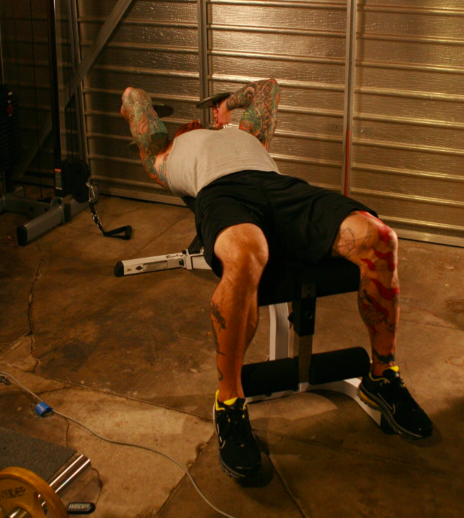SPONSORED
If you spent years in the military following a structured training program, one of your biggest adjustments as a civilian could very well be getting back into a regular fitness routine.
With countless programs online to follow, which do you choose? On JimStoppani.com, I offer dozens of workout plans, and I realize that it can get overwhelming for people. So, first things first: Decide what your weekly workout schedule is going to be. Aka, your training split.
There are many different training splits you can choose from. To keep it simple, I’m going to cover three basic weekly routines in this article: (1) Full-Body Split; (2) Upper Body/Lower Body Split; and (3) Bodypart Split.
Deciding which one fits your schedule, goals, and personal preferences will go a long way to getting you into a routine you can follow for months, and years, to come.
1) Full-Body Split
Days Per Week: Anywhere from 3-6
Benefits of a Full-Body Split: Maximizing fat loss; scheduling flexibility; improved overall conditioning and fitness levels; ideal for beginners and advanced individuals alike.
A full-body split entails training every major muscle group in the body in every workout. I generally recommend full-body training for beginners, yet this is also the routine I follow in my own training – and I’ve been going to the gym for over 30 years! In other words, full-body training is highly adaptable to individuals of all levels.
One of the most appealing benefits of full-body training is that it maximizes fat loss as compared to split-body routines, where different muscle groups are trained on different days. When you work out, fat-burning genes in the muscle you’re training are “turned on.” The more muscles you train, the more such genes that are activated, and the more potential body fat you’ll burn. (In this article on JimStoppani.com, I go into more depth on the science behind full-body training.)
I personally started doing full-body workouts after suffering a major leg injury – a completely ruptured quadriceps tendon – when I was in my late 40s. (I’m 50 now.) At that point, I knew I needed to change the way I trained. I was no longer going to be able to hit legs as hard as I did when I was younger, and I also wasn’t able to do cardio for months after the injury while I was rehabbing.
But I still wanted to stay super lean, so full-body training made a lot of sense for me. I’m able to stay at well under 10% body fat now with no separate “cardio” sessions. I attribute much of this to the fat-burning benefits of full-body training, in addition to a good diet and keeping rest periods short during my workouts.
Aside from being great for fat loss, full-body training is highly flexible from a scheduling standpoint. I do full-body workouts 5-6 days a week, but if you prefer to train 3-4 days a week, it’s conducive to that schedule as well. In fact, beginners (or those just getting back to the gym after an extended layout) should probably start with 3 days per week at first and build up from there.
A typical full-body workout includes 1 or 2 exercises per major muscle group. In my workouts on JimStoppani.com, those muscle groups consist of chest, back, shoulders, legs, triceps, biceps, traps, forearms, abs, and calves. However, if you’re short on time, you can skip some of the smaller body parts like traps, forearms, and calves and still get more or less a full-body workout.
That’s what I mean about this style of training being ultimately “flexible.” On days when you have to get in and out of the gym quickly, do chest, back, legs, shoulders, and arms and be on your way. On days you have more time, hit all 10 muscle groups.
Nearly all of the training programs I’ve designed recently are full-body routines. You can find them on JimStoppani.com in the Train With Jim section on the site.
2) Upper Body/Lower Body Split
Days Per Week: 4
Benefits of a Full-Body Split: Effective for athletes; good for maximizing strength and power.
An upper/lower split – also considered a 2-day split, because the entire body is trained over the course of two days – consists of training your upper body and lower body on separate days. The most common way to use an upper/lower split is to do it four days a weeks; for example, upper body on Monday and Thursday, lower body on Tuesday and Friday, and taking Wednesday, Saturday and Sunday off from the gym.
An upper/lower split is basically a cross between a full-body split and a body part split. Because you’re not training every muscle group every day, you’re able to train with more volume – up to 3-4 exercises per muscle group versus only 1 or 2 as with full-body training. The higher volume, combined with more rest days during the week, is believed by many to be better for building muscular strength and power than full-body training. This is one reason why upper/lower split training is favored by many sport athletes like football and basketball players, where getting stronger and more explosive is critical to performance on the field or court.

Generally speaking, an upper/lower split is ideal for anyone who’d rather not train every muscle group in every workout but who doesn’t quite want to train like a bodybuilder either. And if going to the gym four days a week fits your schedule best, an upper/lower split could make sense for you.
3) Body Part Split
Days Per Week: 4-6
Benefits of a Full-Body Split: Ideal for maximizing muscle size (hypertrophy); customizable to individual schedules and physique goals/weaknesses.
If building muscle is your number one goal, a body part split should probably be your routine of choice – just as it is for a majority of competitive bodybuilders. This is a very broad category. A body part split can train each muscle group either once or twice a week and in a variety of formats: anywhere from a 3-day to a 7-day split.
For example, a 3-day split (where the entire body is trained over the course of three days) usually consists of training each bodypart twice a week – ie, chest, shoulders, and triceps on Monday and Thursday; back and biceps on Tuesday and Friday; and legs on Wednesday and Saturday.

When you get into a 4-6-day split, you’re usually training each bodypart only once a week – ie, chest and triceps on Monday; legs on Tuesday; back and biceps on Thursday; shoulders on Friday. This would be an example of a 4-day split.
Because you’re training only 1-3 body parts per workout, the volume for each muscle group can be high – up to 20+ sets per. This overload in volume plus ample rest time during the week (because you’re only training each bodypart once or twice a week) can lead to big time gains in muscle size, provided you’re following a proper mass-gaining nutrition plan.
As I mentioned before, the possibilities are endless with body part splits and can be tailored to your personal schedule and/or your individual goals and weaknesses. Where the latter is concerned, if you want to focus more on legs than other body parts, for instance, you could schedule legs on the day of the week you tend to have more time and energy to train. Likewise, you could train legs twice a week and everything else once.
Although I’ve been designing mostly full-body workouts lately, I have numerous body part split training programs on JimStoppani.com. You can find them all in the Featured Workouts section of the website.
MORE FITNESS: THE BEST KIND OF CARDIO FOR BURNING FAT










